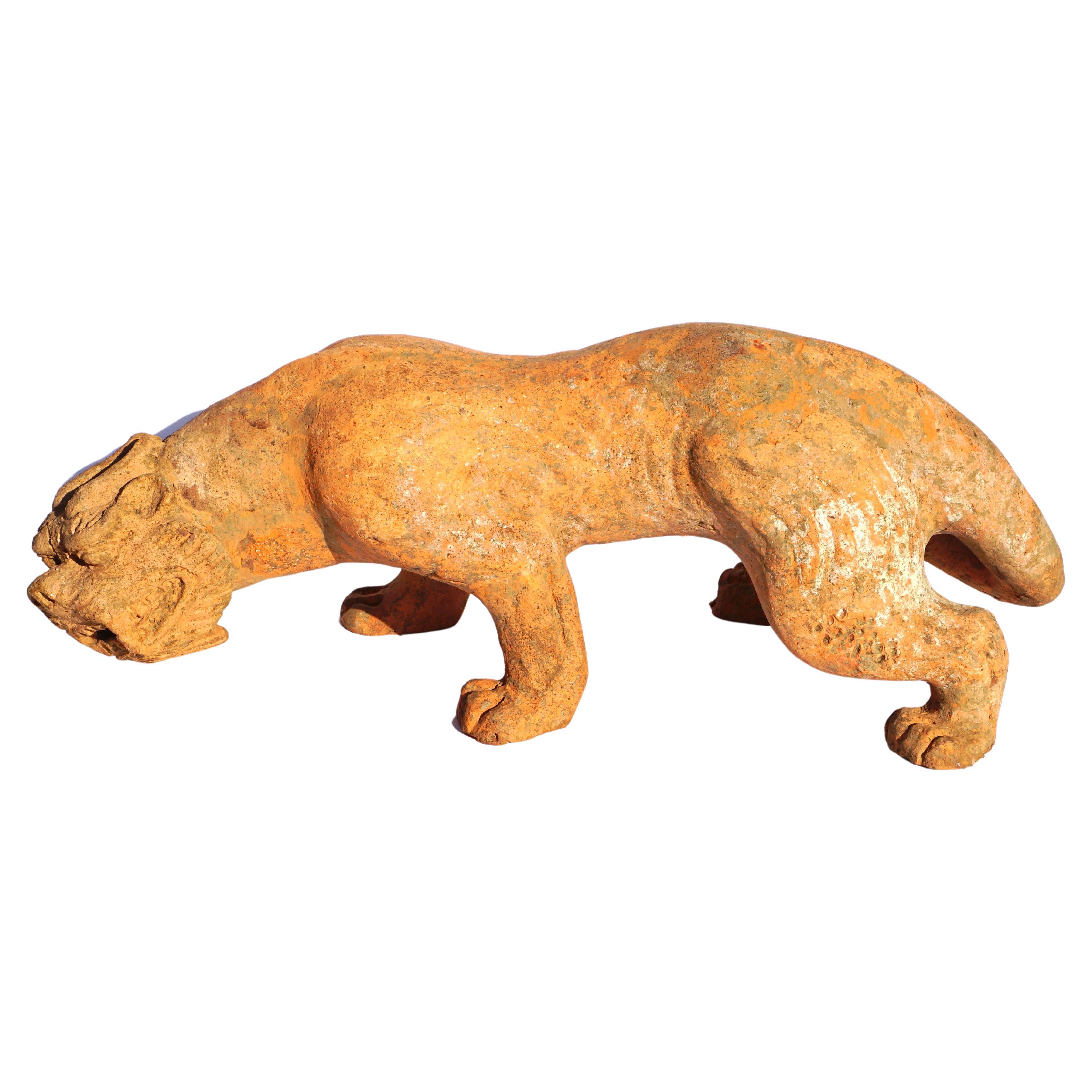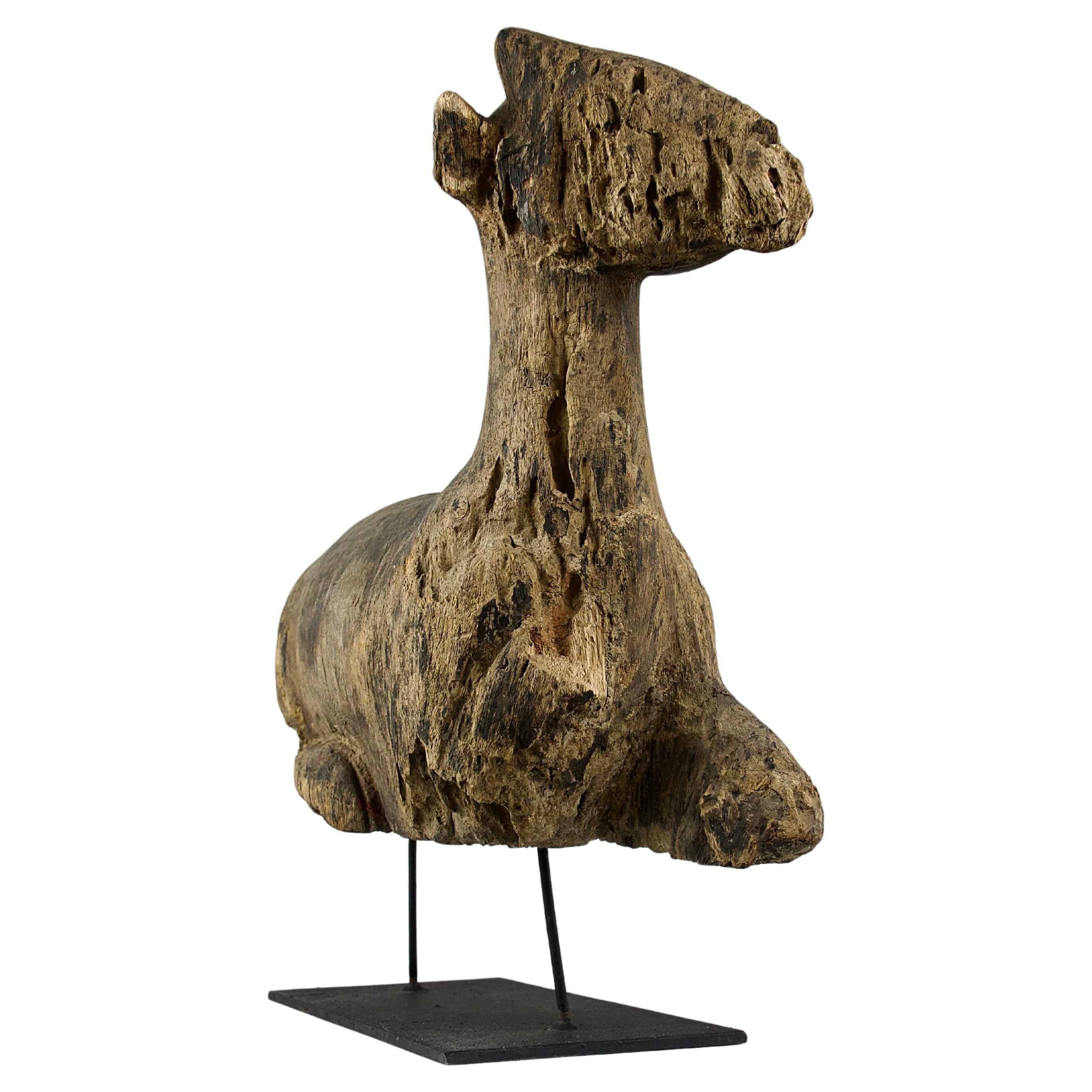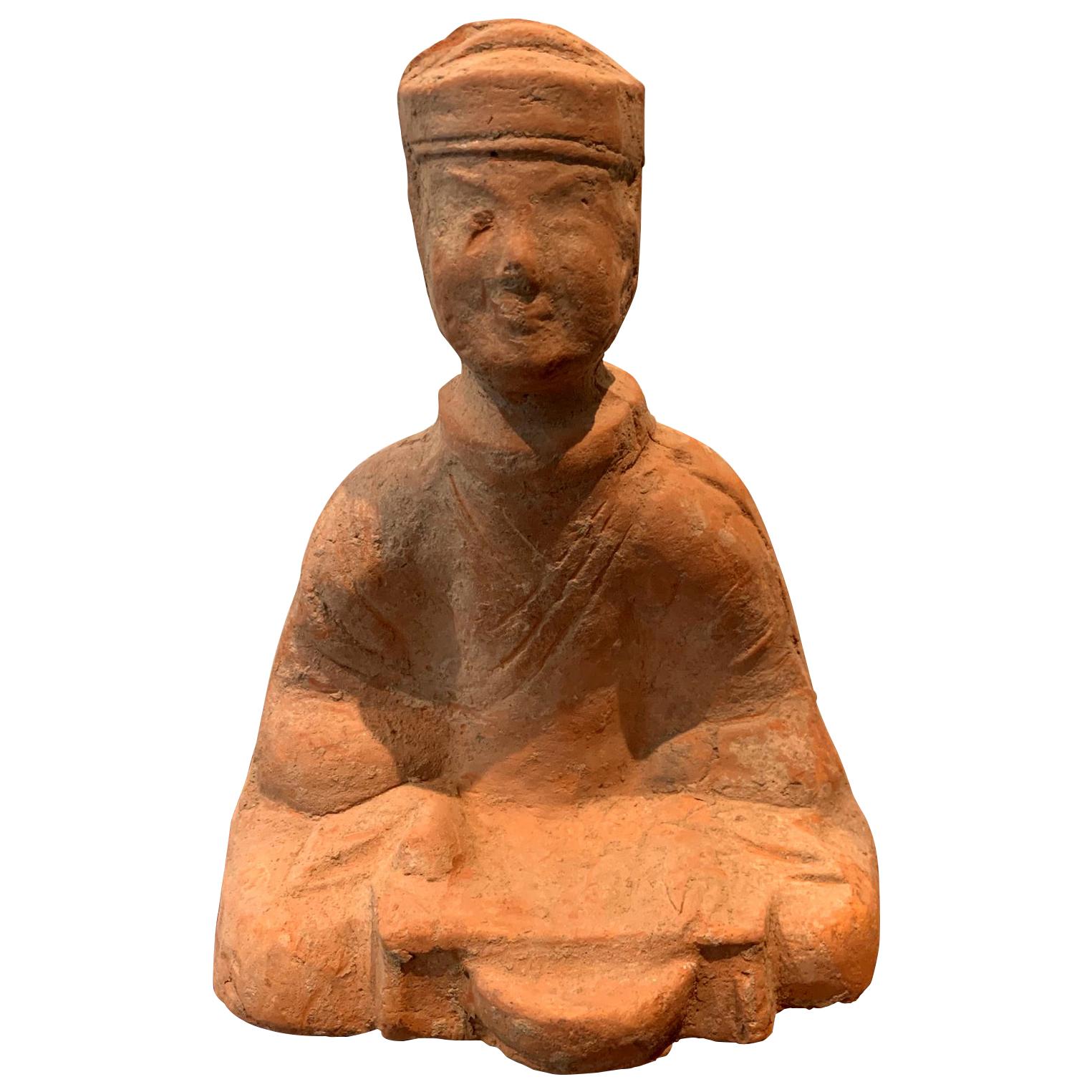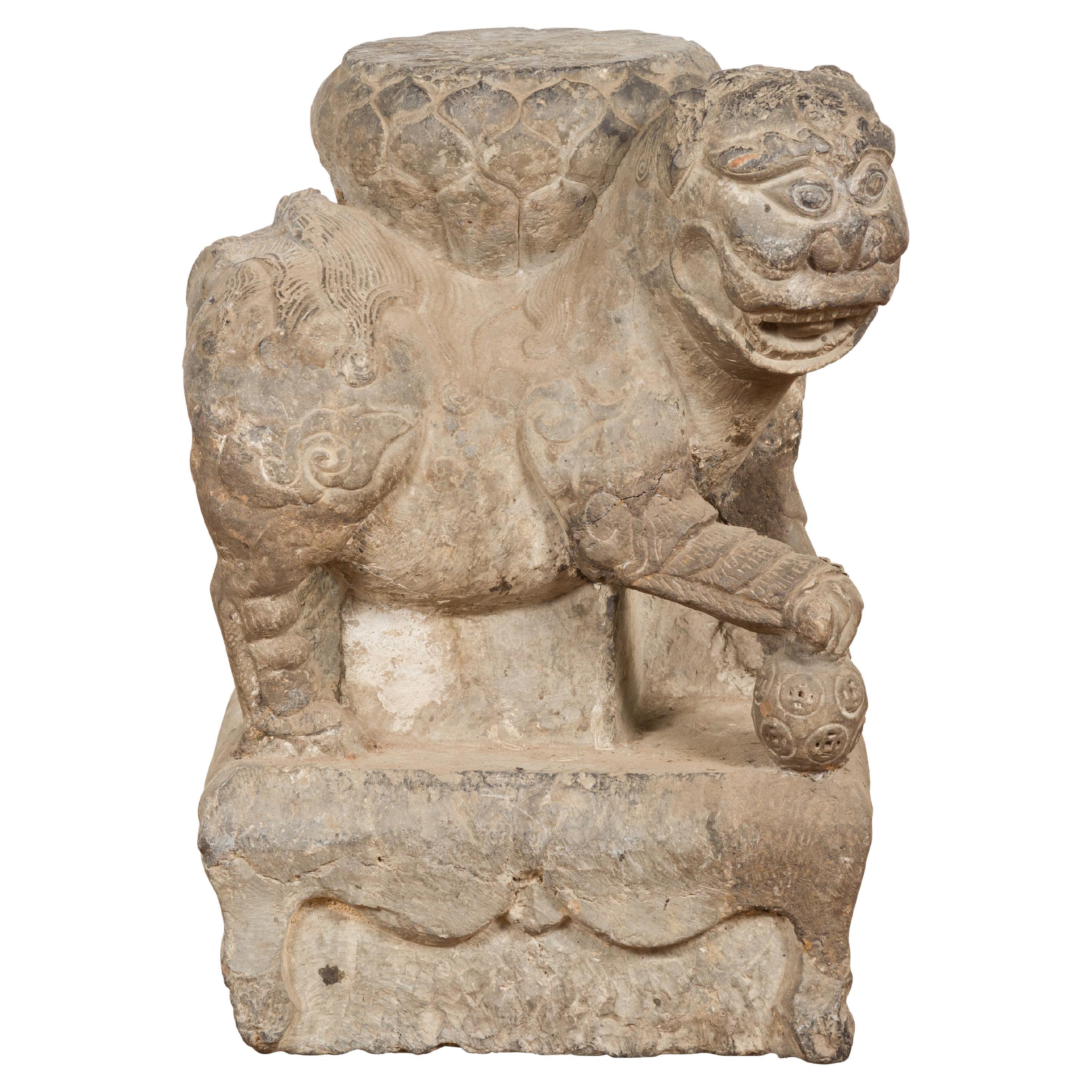Items Similar to Sculpture Dog Sichuan Pottery Han Dynasty Period China
Want more images or videos?
Request additional images or videos from the seller
1 of 9
Sculpture Dog Sichuan Pottery Han Dynasty Period China
About the Item
Sculpture Sichuan pottery walking Han dynasty period, China. A Han sculpture in the shape of a dog. Of the large number of figurines unearthed in burial sites in the city, pottery dogs are among the most unique. These marvelous animated tomb figurines display the dynamic qualities of Han funeral objects and provide a wonderful portrait of everyday life in the Han dynasty. People believed dogs were able to protect them from evil and help them enjoy a peaceful life in heaven. The dog was also one of the 12 signs of the Chinese zodiac, another reason for its popularity as a tomb figurine.
Archaeologists discovered that in the Han Dynasty tombs in Nanyang, both large and small, pottery dogs like this one were always found buried alongside their owners.
TL test from Oxford authentication is available.
- Dimensions:Height: 16.5 in (41.91 cm)Width: 16.5 in (41.91 cm)Depth: 5 in (12.7 cm)
- Style:Han (Of the Period)
- Materials and Techniques:Pottery,Unglazed
- Place of Origin:
- Period:
- Date of Manufacture:206 BCE-220 CE
- Condition:Wear consistent with age and use. TL test from Oxford Authentication is available.
- Seller Location:New York, NY
- Reference Number:1stDibs: LU88299556213
About the Seller
4.2
Recognized Seller
These prestigious sellers are industry leaders and represent the highest echelon for item quality and design.
Established in 1979
1stDibs seller since 2009
227 sales on 1stDibs
Typical response time: 10 hours
- ShippingRetrieving quote...Ships From: New York, NY
- Return PolicyA return for this item may be initiated within 7 days of delivery.
More From This SellerView All
- Urn Chinese Glazed Brown Ming ChinaLocated in New York, NYUrn Chinese Glazed Brown Ming China. A Glaced Ming Urn from China. Made during the Ming Period 1368-1644.Category
Antique 15th Century and Earlier Chinese Ming Jars
MaterialsPottery
- Paintings on Mirror Glass Chinese 18th Century ChinaLocated in New York, NYPaintings on Mirror Glass Chinese 18th Century China. A pair of paintings made on mirrored glass. Made during the 18th century in China. Original fr...Category
Antique 18th Century Chinese Chinese Export Paintings
MaterialsMirror
- Pair of Tazzas, France Empire PeriodLocated in New York, NYA pair of Tazzas from the late part of the Empire period. Made in Red French Marble with a bowl in dark patinated bronze. Base decorated with gilt bronze.Category
Antique 19th Century French Empire Centerpieces
MaterialsMarble, Bronze, Ormolu
- Chinese "A La Chinoise" NightstandLocated in New York, NYA Chinese red lacquered nightstand with "a la chinoise" decorations, brass hardware.Category
Antique 19th Century Chinese Night Stands
MaterialsWood
- Armchair Swedish Early Baroque Period Gilt Leather SwedenLocated in New York, NYArmchair Swedish Early Baroque period gilt leather Sweden. An armchair in a generous size made during the Carolean Baroque Era 1650-1720 period in Swede...Category
Antique Late 17th Century Swedish Baroque Armchairs
MaterialsWood
- Console Table Chinese Black Lacquer with Chinoiserie Gilded 19th Century ChinaLocated in New York, NYConsole Table Chinese Black Lacquer with Chinoiserie Gilded 19th Century China. Sideboard made in China in black lacquer with painted gilded details...Category
Antique Late 19th Century Chinese Chinese Chippendale Side Tables
You May Also Like
- Large Han Dynasty Pottery Sculpture of a DogLocated in Dallas, TXHan Dynasty life size Terracotta sculpture of a dog. Buried in a tomb for thousands of years; this mingqi companion has decided to come back and accompany the living. I’m actually taking a liking to this pup; most probably a fierce pit bull...Category
Antique 15th Century and Earlier Chinese Han Animal Sculptures
MaterialsTerracotta
- Han Dynasty Pottery Sculpture of a Winged Lion Mythical BeastLocated in Dallas, TXA Large Han Dynasty Terracotta sculpture of a Mythical Beast. Possibly a horned tiger but most probably a winged lion often seen in ancient jade sculptures. I cant emphasize how ra...Category
Antique 15th Century and Earlier Chinese Han Animal Sculptures
MaterialsPottery
- Han Dynasty Pottery Horse and RiderLocated in Dallas, TXHan Dynasty painted pottery horse and rider A Chinese Han Dynasty painted pottery horse & rider. Made from grey pottery and cold-painted in white, red and black pigments. The rider dressed as a warrior and in the pose of holding reins for the horse. Comes with a custom sturdy lucite stand. Measures: Height: 13.5 inches (33cm). Length: 13 inches Depth: 5 inches Han Dynasty (206 BC – AD 220). Condition: Very good with past restoration to legs. The great influence of the horse throughout the history of China can...Category
Antique 15th Century and Earlier Chinese Han Animal Sculptures
MaterialsPottery
- Han Dynasty, Laying Doe Wood Sculpture, China 100ADLocated in PARIS, FRSuperb sculpture of a laying doe from the Chinese Han Dynasty (206BC-220AD). Remainders of polychromic paint, namely red, symbol of good fortune and joy as well as the season of summer, and green, symbol of vigor and vitality and the season of spring. Mounted on base. Condition seen in pictures. Dimensions in cm ( H x L x l ) : - Sculpture : 35 x 40 x 10 - With base : 45.5 x 44 x 15 The Han Dynasty ruled China from 206 B.C. to 220 A.D. and was the second imperial dynasty of China. It is known for its promotion of Confucianism as the state religion and opening the Silk Road trade route to Europe, permanently altering the course of Chinese history. Han Dynasty art and inventions like paper still influence the world today. From the Han Dynasty to the present, deer can be found in many materials and media—rock crystal, nephrite, ink on paper, porcelain, cloisonné enamel, jade, bamboo root, textile, bronze, etc.—alone or in groups, among trees and rocks and in various positions. They appear on everyday objects, from boxes to incense burners, incense holders, lamps, mirror holders and the droppers scholars used when they wrote. A symbol of longevity and grace in Chinese mythology, the word deer is pronounced lu, a homonym for emoluments—favors granted to officials. They therefore represent wealth, nobility and success in imperial examinations (civil service exams for selecting candidates for the state bureaucracy in Imperial China). Deer were the faithful companions of Shu Lao, the god of longevity, and the goddess Magu. They were reputed to live long and to be the only creature able to find the mushroom of immortality, linghzhi. Although its spots are different, deer are sometimes confused or associated with stags, a Manchu hunting trophy whose antlers served to make prestigious furniture. (La Gazette Drouot, Claire Papon) For the colours found on this piece, in Chinese culture, red symbolizes good fortune and joy. Green, symbolizes the spring when everything is brimming over with vigor and vitality. The Han Dynasty (206 B.C. to 220 A.D.) continued the Qin Dynasty’s use of dark colours, but incorporated red. During the earlier years, or Western Han Dynasty, ordinary people wore red while court dress was black. Shoes were red in color. The clothing worn for sacrificial rites was black edged with red. In the later Eastern Han Dynasty, red symbolized the dynasty’s “fire Virtue” and became predominant. Court dress was red. Sacrificial rites called for a red-edged white layer under robes with red socks...Category
Antique 15th Century and Earlier Chinese Han Mounted Objects
MaterialsWood
- Chinese Terracotta Tomb Figure East Han DynastyLocated in Atlanta, GAA small Chinese terracotta tomb figure (Ni Yong) from East Han dynasty (25-220 AD), likely from the area of nowadays Sichuan. It depicts a sitting male wit...Category
Antique 15th Century and Earlier Chinese Han Ceramics
MaterialsTerracotta
- Chinese Ming Dynasty Period Male Foo Dog Guardian Lion Hand-Carved SculptureLocated in Yonkers, NYA Chinese Ming Dynasty period (1368 - 1644) hand-carved stone Foo Dog guardian lion sculpture depicting a male placing his paw atop a ball. Created in Ch...Category
Antique 17th Century Chinese Ming Sculptures and Carvings
MaterialsStone
Recently Viewed
View AllMore Ways To Browse
Han Period
Antique Chinese Portraits
Used Office Furniture Oxford
Chinese Tomb
Chinese Zodiac
Antique Funeral
Early Chinese Dog
Hans Dynasty Sculpture
Dynasty Portrait
Sign Funeral
Burial Sculpture
Antique Zodiac Signs
Oxford China
Antique China Figurines
Antique Chinese Figurine
Antique Chinese Figurines
Decorative Figurine Chinese
Antique Dog Figurines





